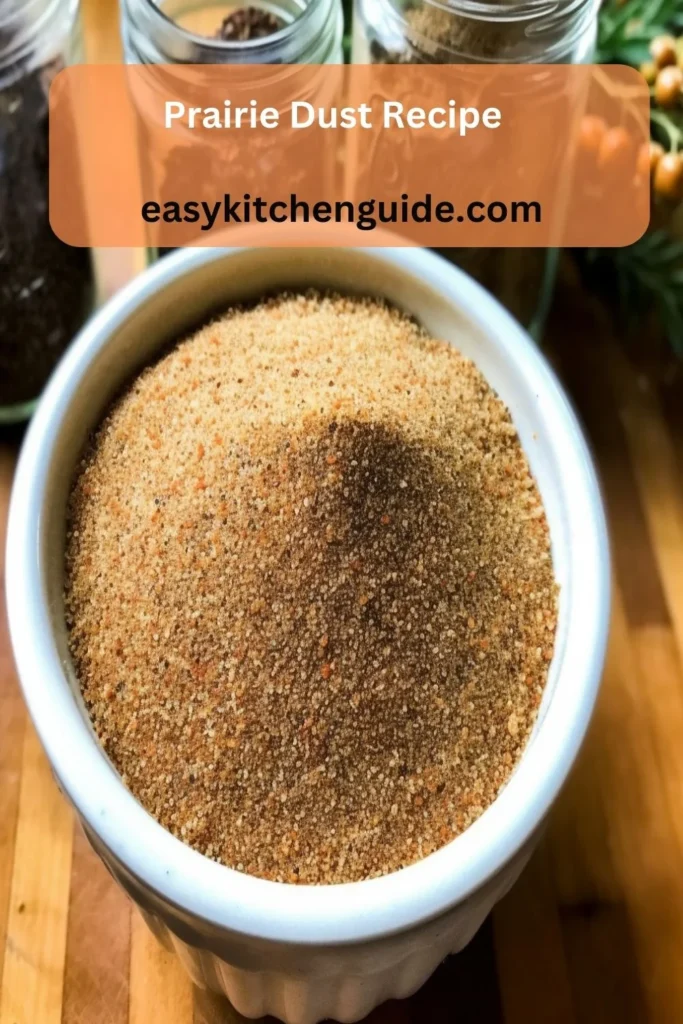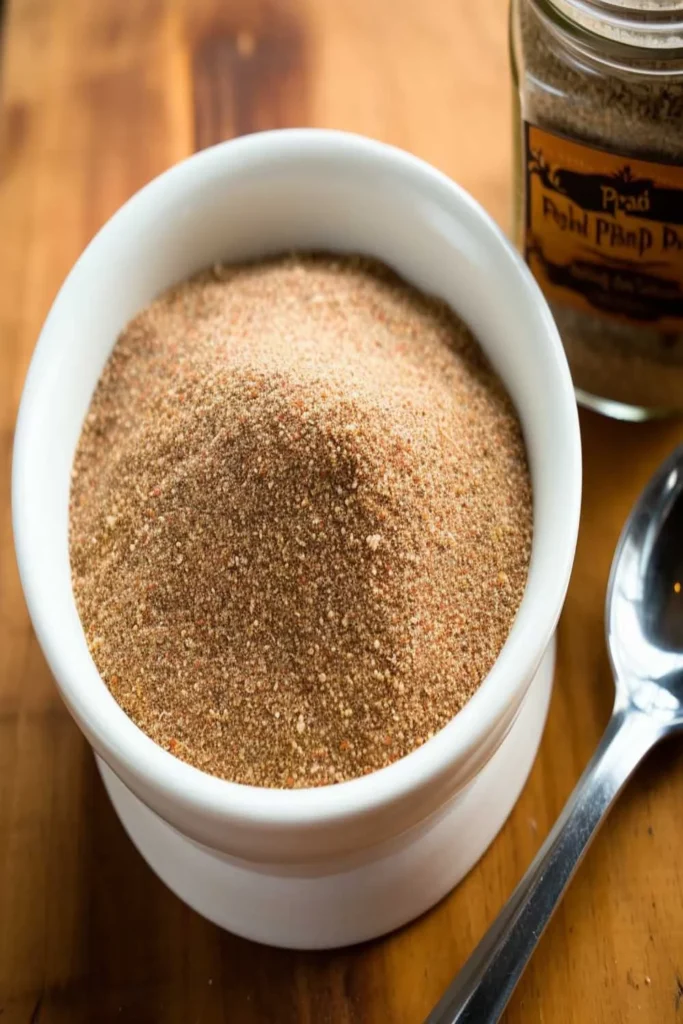Get ready to experience the heart of the American Midwest with our Prairie Dust recipe. This versatile spice blend, often hailed as a hidden gem of the culinary world, has its roots deep in the open, wind-swept plains of the prairies. It’s a mouthwatering mix of flavors that captures the essence of hearty, home-cooked meals shared by generations of families living amidst the sprawling grasslands.
From grilling meats to spicing up your favorite stew, this Prairie Dust recipe is your ticket to a robust and savory adventure. So, put on your apron, and let’s journey together into the heartland of America, one delicious bite at a time.

What is prairie dust?
Prairie Dust is a unique spice blend that originated in the American Midwest. It is a combination of various herbs and spices, carefully chosen to bring out the flavors of prairie cuisine. The name “Prairie Dust” comes from the fact that it was often used by settlers on the plains to add flavor to their meals, just as dust covers everything on the prairie.
The origins of Prairie Dust are deeply rooted in the rich history and traditions of the American Midwest. Settlers and pioneers who made their homes on the expansive prairies had to rely on limited ingredients to create flavorful meals. With a mix of herbs and spices commonly found in the region, they created a seasoning that would become a staple in their cooking for generations to come.
Why You’ll Love This Prairie Dust?
Prairie Dust is more than just a spice blend; it’s a taste of history and tradition. Its robust combination of flavors brings to life the essence of prairie cuisine and the spirit of the Midwest. This versatile seasoning can be used in a variety of dishes, from grilled meats to soups and stews, adding depth and complexity to your meals.
Moreover, Prairie Dust is made with natural and simple ingredients, free from any artificial additives or preservatives. It’s a healthier alternative to store-bought seasonings that often contain high amounts of sodium and other unhealthy ingredients. By using Prairie Dust in your cooking, you can enhance the flavors of your dishes without sacrificing your health.
You’ll also like the following Sauces recipes!
- O Charley’s Honey Mustard Copycat Recipe
- How to Make Ina Garten Brown Butter Sage Sauce
- Chicago Mild Sauce
Ingredients
- Paprika: This spice is made from ground dried red fruits of sweeter varieties of the pepper plant. It provides a sweet peppery flavor and a bright red color to the mix. Paprika is a key ingredient in many types of cuisines, especially Hispanic and Mediterranean.
- Garlic Powder: Made from dehydrated garlic, this powder brings a savory depth that fresh garlic often can’t match. It’s a great way to add a robust garlic flavor without the hassle of peeling and chopping fresh garlic.
- Onion Powder: Similar to garlic powder, onion powder offers a convenient way to add oniony flavor to dishes. It’s made from dehydrated onions and works well in spice blends because it disperses evenly throughout the mix.
- Chili Powder: This ingredient can be a blend of spices or pure ground chilis. It adds a spicy kick to the mix. The heat level can vary greatly depending on the type of chili used, allowing for customization of the spice blend’s overall heat.
- Cumin: Cumin has a warm, earthy flavor and aroma with hints of lemon and sweetness. It’s often used in Middle Eastern, Indian, and Mexican cuisines. It’s a key component in this mix, adding complexity and a distinctive taste.
- Smoked Paprika: Smoked paprika is essentially paprika that’s been smoked over an oak fire. It adds a smoky flavor to the spice mix, giving a barbeque-like flavor even if you’re cooking indoors.
- Black Pepper: Known for its sharp, spicy heat, black pepper adds a layer of complexity, enhancing other flavors in the spice mix.
- Dried Oregano: This herb adds a slightly bitter, pungent flavor. It’s often used in Mediterranean and Mexican cuisines and pairs well with the other spices in this mix.
- Dried Thyme: Thyme has a subtle, dry aroma and a slightly minty flavor. It complements most ingredients and adds a layer of depth to the overall flavor profile of the spice mix.
- Sea Salt: Salt is essential in almost all recipes. It enhances the flavors of the other spices and brings balance to the overall taste of the spice mix. Sea salt is often favored for its clean, pure taste.

Directions
Step 1: Customize the Heat Level
Adjust the amount of chili powder to suit your preferred level of spiciness. If you want a unique flavor, experiment by mixing in different types of chilis. This customization allows you to tailor the heat to your taste buds and create a distinct flavor profile.
Step 2: Achieve a Finer Texture
For a smoother and more refined texture, consider grinding the spices together. You can use a spice grinder or a mortar and pestle for this purpose. This step enhances the blend’s consistency and ensures that all the flavors meld together seamlessly.
Step 3: Personalize with Additional Herbs and Spices
Feel free to take creative liberties by adding other herbs and spices to the Prairie Dust blend. Consider options like smoked paprika, coriander, or dried mustard to enhance the flavor profile according to your preferences. This customization adds depth and complexity to your spice mix.
Step 4: Opt for Quality Ingredients
To achieve the best flavor, it’s important to use quality spices. Choose organic and non-GMO options if available. High-quality spices will make a noticeable difference in the overall taste and aroma of your Prairie Dust blend.
Step 5: Share the Joy of Cooking
If you enjoy your Prairie Dust creation, why not consider making a larger batch and sharing it as a thoughtful gift with friends and family who love cooking? Homemade spice blends make for delightful and personalized presents that showcase your culinary expertise.
Notes
- Adjust the amount of chili powder to suit your preferred level of heat. You can also mix in different types of chilis for a unique flavor profile.
- For a finer texture, you can grind the spices together using a spice grinder or mortar and pestle.
- You can add other herbs and spices to customize the blend according to your taste, such as smoked paprika, coriander, or dried mustard.
- Use quality spices to ensure the best flavor – opt for organic and non-GMO options if possible.
- Make a larger batch of Prairie Dust and give it as a gift to your friends and family who love cooking. It’s a thoughtful and delicious present!
Storage Tips
To keep your Prairie Dust fresh and flavorful, store it in an airtight container in a cool, dry place. Avoid exposing it to heat or sunlight, as this can cause the spices to lose their potency and flavor. You can also store it in the fridge or freezer for extended shelf life.

Nutrition Information
Serving Suggestions
Sprinkle Prairie Dust over your favorite dishes to elevate their flavors. Here are a few serving suggestions:
- Use it as a rub for grilled meats – chicken, pork, beef, or fish.
- Add it to soups and stews for an extra layer of flavor.
- Sprinkle it over popcorn for a tasty snack.
- Mix it with olive oil to create a flavorful marinade for vegetables.
- Use it as a seasoning for roasted potatoes or sweet potato fries.
- Add it to ground beef when making burgers or meatballs for a delicious twist.
What other substitute can I use in prairie dust?
Although Prairie Dust is already a well-balanced and versatile spice blend, there are some substitutions you can make if needed. Here are a few options:
- Smoked Paprika: If you don’t have smoked paprika on hand, you can use regular paprika or even chipotle powder for a similar smoky flavor. Just keep in mind that chipotle powder will add a bit more heat to the mix.
- Dried herbs: If you don’t have dried oregano or thyme, you can substitute them with other dried herbs like basil, parsley, or rosemary. Just make sure to adjust the quantities accordingly as different herbs have varying potency.
- Sea Salt: You can use any type of salt in place of sea salt, such as table salt or Himalayan salt. Keep in mind that the texture and flavor may differ slightly.
- Garlic Powder and Onion Powder: If you don’t have these ingredients, you can use fresh minced garlic and finely chopped onions instead. Just keep in mind that the flavor will be a bit different, but it will still add depth to the spice mix.

Prairie Dust Recipe
Ingredients
- 1 cup paprika
- 2 tbsp smoked paprika
- 2 tbsp black pepper
- 1/2 cup garlic powder
- 2 tbsp dried oregano
- 1/2 cup onion powder
- 2 tbsp dried thyme
- 1/2 cup chili powder
- 2 tbsp sea salt
- 1/2 cup cumin
Instructions
- Modify chili powder quantity for desired spiciness or try different chilis for unique flavors.
- Grind spices using a grinder or mortar and pestle for a finer consistency.
- Add herbs like smoked paprika, coriander, or dried mustard to customize the blend.
- Use high-quality, preferably organic and non-GMO spices for the best flavor.
- Make extra Prairie Dust for thoughtful homemade gifts to fellow cooking enthusiasts.
Notes
- Adjust the amount of chili powder to suit your preferred level of heat. You can also mix in different types of chilis for a unique flavor profile.
- For a finer texture, you can grind the spices together using a spice grinder or mortar and pestle.
- You can add other herbs and spices to customize the blend according to your taste, such as smoked paprika, coriander, or dried mustard.
- Use quality spices to ensure the best flavor – opt for organic and non-GMO options if possible.
- Make a larger batch of Prairie Dust and give it as a gift to your friends and family who love cooking. It’s a thoughtful and delicious present!
FAQs
Can I make a milder version of the Prairie Dust spice blend?
Absolutely! The beauty of making your spice blend is that you can adjust the ingredients to suit your taste. If you’re not fond of heat, reduce the amount of chili powder. Conversely, if you like your food spicier, feel free to add more.
Why does the Prairie Dust blend include both paprika and smoked paprika?
While they come from the same type of pepper, paprika, and smoked paprika offer different flavors. Regular paprika is sweet and slightly fruity, while smoked paprika has a distinctive smoky flavor. Including both in the blend creates a complex, layered taste.
Is there a difference between using sea salt and table salt in the Prairie Dust spice blend?
While both types of salt perform the same basic function of enhancing flavor, sea salt is often considered to have a purer, more natural taste compared to table salt. Sea salt also has larger, coarser grains, which can add a slight crunch to the finished dish.
Can I use fresh herbs instead of dried ones in the Prairie Dust blend?
While fresh herbs are wonderful in many recipes, in a spice blend like this, dried herbs are preferred. Dried herbs are more concentrated in flavor and won’t affect the shelf life of your spice blend as fresh herbs would.
Conclusion
Prairie Dust is more than just a seasoning; it’s a taste of history and tradition. Its robust flavor profile and simple ingredients make it a versatile and healthier option for adding depth to your dishes. So, grab your apron, mix up a batch of Prairie Dust, and let the flavors of the American Midwest take over your kitchen. Happy cooking!
Don’t forget to share your prairie dust creations with us. So, we can all celebrate and appreciate the delicious flavors of prairie cuisine together. Enjoy!
You’ll also like the latest recipes!
Dr. Leah Alexander, M.D., is a board-certified Pediatrician in New Jersey and has been working at Elizabeth Pediatric Group of New Jersey since 2000.
She also has a passion for culinary arts that extends beyond the medical realm. After completing culinary school at the French Culinary Institute, she started Global Palate, LLC, a catering firm, in 2007. She ran her own six-year-old catering company and served small group parties as an owner and executive chef.
